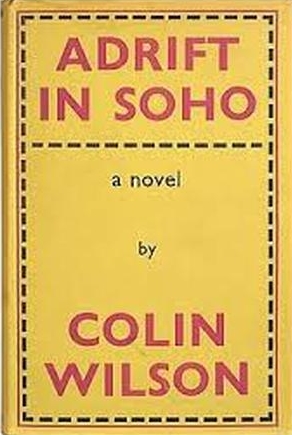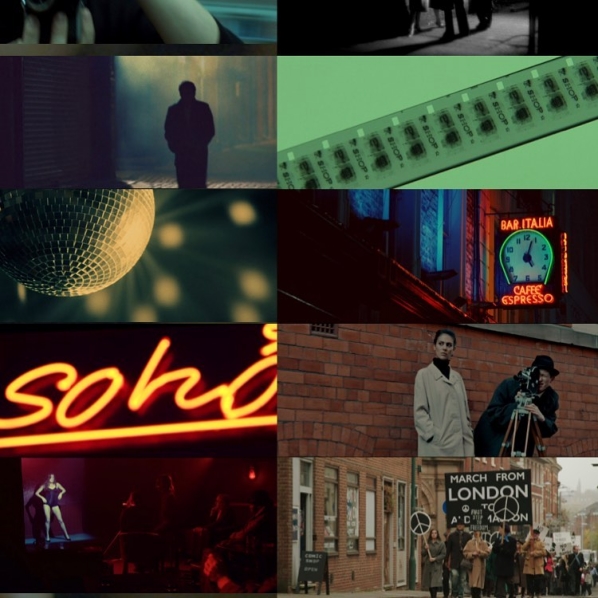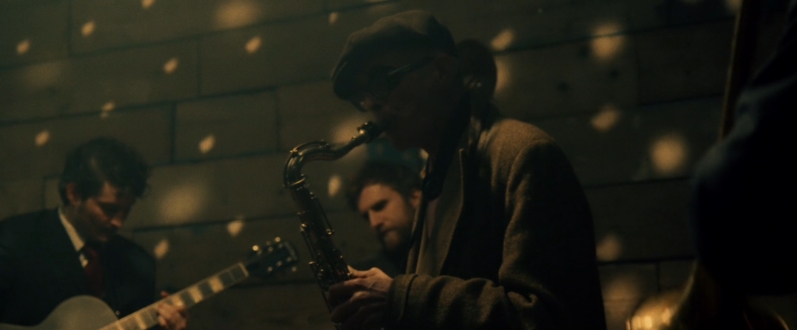“Let me
show you Soho!’
James is the
hyperactive Trickster who initially mesmerises everyone who encounters him,
whether in the pub, coffee bar or greasy spoon cafe. While Harry broods about
the meaning of ‘Sohoitis’, with a growing recognition that there
might be ‘no exit strategy’ and yearns for Doreen, James seduces a
young writer, played with beguiling innocence by Tori Hope. He claims to be a
publisher who knows ‘Osborne, Wilson, Pinter and Dylan Thomas’. Soon
her post-orgasmic cry of ‘Dylan Thomas!’ echoes across the Soho
rooftops into the night sky. She’s unaware , of course, of his on-off
relationship with Myra, a struggling actress, Unsurprisingly, James proposes a
financial partnership with Harry, whereby each supports the other over a
fortnightly cycle without working, using cunning and ingenuity, an arrangement
that quickly becomes as stressful as a full time job, even when James busks the
West End theatre queues with his comic monologues.
Yet Harry is also
drawn to a more cerebral figure, the semi-vagrant self-styled ‘Count
Robert De Bruin’ (William Chubb) who offers to sell him a first edition of
the nineteenth century proto-surrealist novel Les Chants de Maldoror by Comte
de Lautréamont. Its nightmarish scenes of horror and violence impress
both Harry and James, who frequently quotes from the work, foreshadowing his
final crisis. For beneath the drinking, partying and numerous beddings by James
there’s a hint of an underlying angst, another foreshadowing of the next
decade and the dread of nuclear warfare, as identified in Jeff Nuttall’s
classic study of the 1960s, Bomb Culture. There are certainly sombre undertones
in the ‘Anarchist Theatre’ cabaret that Harry visits. Based on an
event that Wilson himself helped to organise, it includes a fragment of a
lecture on Nietzsche and the Outsider, but a female poet (Hayley Considine)
commands the most attention with a diatribe of self-hatred and nausea directed
at her own bodily decay and a denunciation of society as
‘parasitical’. There’s a similar nihilism evident in a brief
cameo from an unnamed artist perhaps based on Francis Bacon, ‘I prefer the
visceral reality of a vomit...that’s why I’m in Soho... I may move
out to suburbia and disfigure it...’
Even frenetic dancing
in a jazz club under the spinning glitter ball seems propelled by a wild
desperation, a ritual of Eros versus Thanatos. Despite James’ extroversion
in the saloon bar in front of his entourage, extravagantly praising
Harry’s ’genius’ as a stratagem to get him off with Doreen, he
also dramatises his ambivalence about Soho, ‘you lover of the dilettante
and the complete failure...what can you give me except nausea...’ Harry
later admits that ‘happiness is a rare commodity here. The difference is
that people are not looking for it. Soho is an enclave , keeping doubt
permanently switched on.’ Trying weed to a party sound track of skiffle
and bomb-protest folk , snorting coke in a strip joint as a dancer in a black
leotard begins her routine, Harry shares some of James’ hedonism but
confesses to Doreen that he has ‘found a thousand of ways of living -
without actually doing anything.’
‘Maybe the
present reality cannot be sustained for much longer...’
Behrens departs from
the novel and sharpens its focus by bringing closure to the intertwined quests
of Harry and James. Finally rejected by Myra, James admits he faces the void.
He drifts into the strip club, where a dealer persuades him to sample LSD.
‘This will be the rage of the next ten years!’ But the dancer on
stage is transformed from seductress to menacing nemesis, pointing an accusing
finger.
He seeks refuge in the
club toilet but can’t escape from the imploding reality of the trip or the
impulse of self-annihilation. Enacting a scene for Maldoror he begins sawing
away at his face with a knife. His mouth, so often his instrument of persuasion
and seduction, is morphed it into a hideous gory parody of a grin, before he
slowly bleeds to death on the stairs.
At James’ wake
Harry reads the extract from Maldoror that features oral mutilation: ‘His
laugh didn’t resemble that of human beings. He wasn’t laughing at
all...’ Mourners return to the pub as Jo and Marty film the hearse
trundling away. In the toilet James’ voice still echoes in Harry’s
head but now he has a commitment. ‘I’m with someone.’ He has
finished his book, and realises that he and Doreen are free to leave Soho.
Now Soho has been
largely sanitised. As rents and local taxes have soared, many of the clubs and
family businesses have been replaced by franchises while tourists vastly
outnumber indigenous itinerants. The likes of Iron Foot Jack and the Count seem
long gone. The social and artistic freedoms sought by Harry’s impoverished
friends have been acted out across six decades. Wilson’s novel captured a
culture on the cusp of change. Behren’s film evokes this seminal period
with nuance, wit and moments of intense beauty.
©Paul
Green July 2020
*Check out PG's
website: https://www.paulgreenwriter.co.uk/poetry/
»»
|


